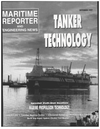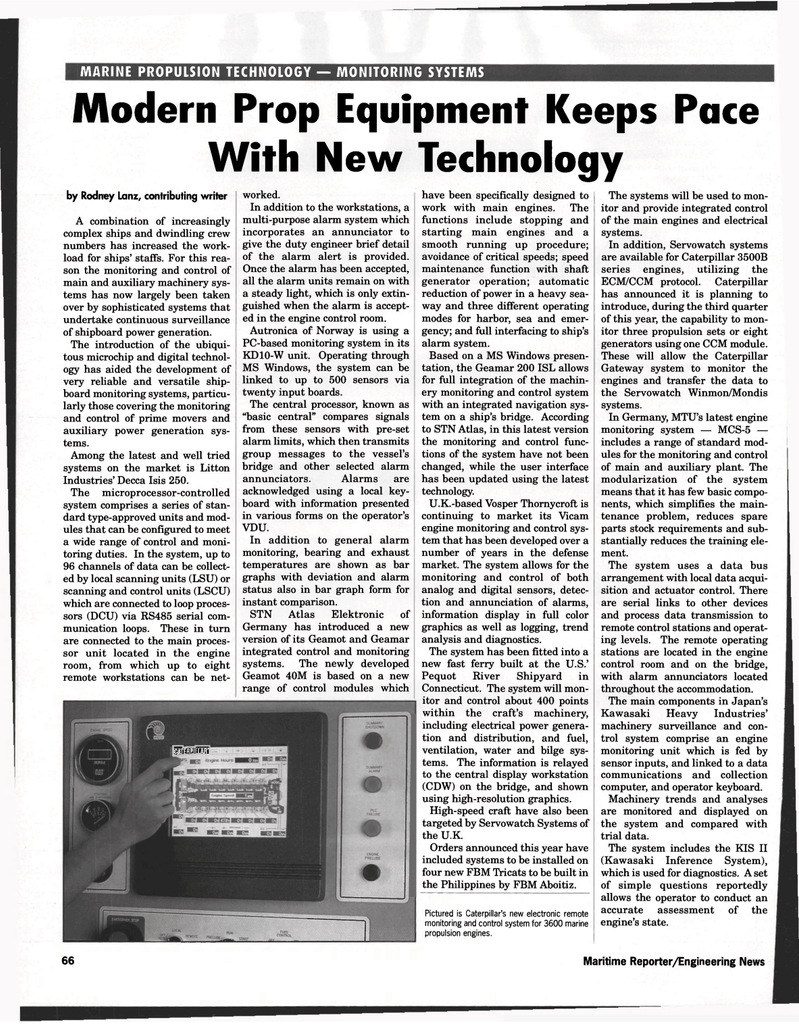
Page 66: of Maritime Reporter Magazine (September 1997)
Read this page in Pdf, Flash or Html5 edition of September 1997 Maritime Reporter Magazine
MARINE PROPULSION TECHNOLOGY — MONITORING SYSTEMS
Modern Prop Equipment Keeps Pace
With New Technology by Rodney Lanz, contributing writer
A combination of increasingly complex ships and dwindling crew numbers has increased the work- load for ships' staffs. For this rea- son the monitoring and control of main and auxiliary machinery sys- tems has now largely been taken over by sophisticated systems that undertake continuous surveillance of shipboard power generation.
The introduction of the ubiqui- tous microchip and digital technol- ogy has aided the development of very reliable and versatile ship- board monitoring systems, particu- larly those covering the monitoring and control of prime movers and auxiliary power generation sys- tems.
Among the latest and well tried systems on the market is Litton
Industries' Decca Isis 250.
The microprocessor-controlled system comprises a series of stan- dard type-approved units and mod- ules that can be configured to meet a wide range of control and moni- toring duties. In the system, up to 96 channels of data can be collect- ed by local scanning units (LSU) or scanning and control units (LSCU) which are connected to loop proces- sors (DCU) via RS485 serial com- munication loops. These in turn are connected to the main proces- sor unit located in the engine room, from which up to eight remote workstations can be net- worked.
In addition to the workstations, a multi-purpose alarm system which incorporates an annunciator to give the duty engineer brief detail of the alarm alert is provided.
Once the alarm has been accepted, all the alarm units remain on with a steady light, which is only extin- guished when the alarm is accept- ed in the engine control room.
Autronica of Norway is using a
PC-based monitoring system in its
KD10-W unit. Operating through
MS Windows, the system can be linked to up to 500 sensors via twenty input boards.
The central processor, known as "basic central" compares signals from these sensors with pre-set alarm limits, which then transmits group messages to the vessel's bridge and other selected alarm annunciators. Alarms are acknowledged using a local key- board with information presented in various forms on the operator's
VDU.
In addition to general alarm monitoring, bearing and exhaust temperatures are shown as bar graphs with deviation and alarm status also in bar graph form for instant comparison.
STN Atlas Elektronic of
Germany has introduced a new version of its Geamot and Geamar integrated control and monitoring systems. The newly developed
Geamot 40M is based on a new range of control modules which have been specifically designed to work with main engines. The functions include stopping and starting main engines and a smooth running up procedure; avoidance of critical speeds; speed maintenance function with shaft generator operation; automatic reduction of power in a heavy sea- way and three different operating modes for harbor, sea and emer- gency; and full interfacing to ship's alarm system.
Based on a MS Windows presen- tation, the Geamar 200 ISL allows for full integration of the machin- ery monitoring and control system with an integrated navigation sys- tem on a ship's bridge. According to STN Atlas, in this latest version the monitoring and control func- tions of the system have not been changed, while the user interface has been updated using the latest technology.
U.K.-based Vosper Thornycroft is continuing to market its Vicam engine monitoring and control sys- tem that has been developed over a number of years in the defense market. The system allows for the monitoring and control of both analog and digital sensors, detec- tion and annunciation of alarms, information display in full color graphics as well as logging, trend analysis and diagnostics.
The system has been fitted into a new fast ferry built at the U.S.'
Pequot River Shipyard in
Connecticut. The system will mon- itor and control about 400 points within the craft's machinery, including electrical power genera- tion and distribution, and fuel, ventilation, water and bilge sys- tems. The information is relayed to the central display workstation (CDW) on the bridge, and shown using high-resolution graphics.
High-speed craft have also been targeted by Servowatch Systems of the U.K.
Orders announced this year have included systems to be installed on four new FBM Tricats to be built in the Philippines by FBM Aboitiz.
Pictured is Caterpillar's new electronic remote monitoring and control system for 3600 marine propulsion engines.
The systems will be used to mon- itor and provide integrated control of the main engines and electrical systems.
In addition, Servowatch systems are available for Caterpillar 3500B series engines, utilizing the
ECM/CCM protocol. Caterpillar has announced it is planning to introduce, during the third quarter of this year, the capability to mon- itor three propulsion sets or eight generators using one CCM module.
These will allow the Caterpillar
Gateway system to monitor the engines and transfer the data to the Servowatch Winmon/Mondis systems.
In Germany, MTU's latest engine monitoring system — MCS-5 — includes a range of standard mod- ules for the monitoring and control of main and auxiliary plant. The modularization of the system means that it has few basic compo- nents, which simplifies the main- tenance problem, reduces spare parts stock requirements and sub- stantially reduces the training ele- ment.
The system uses a data bus arrangement with local data acqui- sition and actuator control. There are serial links to other devices and process data transmission to remote control stations and operat- ing levels. The remote operating stations are located in the engine control room and on the bridge, with alarm annunciators located throughout the accommodation.
The main components in Japan's
Kawasaki Heavy Industries' machinery surveillance and con- trol system comprise an engine monitoring unit which is fed by sensor inputs, and linked to a data communications and collection computer, and operator keyboard.
Machinery trends and analyses are monitored and displayed on the system and compared with trial data.
The system includes the KIS II (Kawasaki Inference System), which is used for diagnostics. A set of simple questions reportedly allows the operator to conduct an accurate assessment of the engine's state.
EopRiiii 66 Maritime Reporter/Engineering News

 65
65

 67
67
